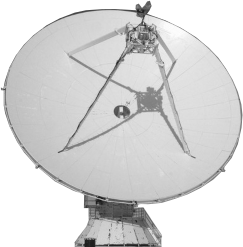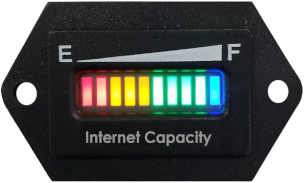Short answer, no, it is not. The equipment we install at your site does resemble the equipment used for satellite TV and Internet providers, but our equipment is located on towers just a few miles from your home, not on a satellite in geosynchronous orbit, 22,300 miles above the Earth.
Here’s why that matters:
 | 1. Latency: Latency refers to the amount of time it takes a data packet to go from you, to the internet, and back. Since the fastest any data can travel is the speed of light, and the connection from your home to our fiber connection can be up to 100 miles, that round trip is still much faster to travel than the path for satellite, which has to go from the earth, to the satellite, then out to the internet, then the return packet has to make the same trip in reverse. That means, even if the data center you were accessing was located at the site on Earth where the satellite signals go, it would still have a round trip of more than 89,000 miles! That’s nearly a half-second at best, and that slowdown can have a huge effect on gaming, voice or video communications, and even the kind of VPNs (Virtual Private Networks) used by many who utilize the Internet to work from home. |
| 2. Weather: Satellite systems, because they communicate with a satellite in orbit, must send and receive data through every layer of the atmosphere. Of course, clouds, especially rain clouds, contain moisture, which can absorb the microwaves carrying the data. Actual rain and thunderstorms make it worse, and satellite systems can suffer weather-related disruptions under a variety of conditions. As our system uses terrestrial towers, the signal travels much closer to the ground the whole time, and is much less likely to be disrupted unless the storm is very severe. |  |
 | 3. Capacity issues: The Internet is becoming more vital to people every day, and that means people are using it much more heavily than they ever had before. For a company like ours, increasing capacity means buying new equipment and sending a crew to a tower to climb the tower and install it. It does cost money, and it’s work, to be sure, but it’s not that difficult. When a satellite provider needs to add capacity, they would have to launch a new satellite into orbit, which costs hundreds of millions of dollars, so they don’t do it often. Instead, they ration their limited bandwidth by giving a very restricted amount of usage during peak usage hours (6pm to 11pm), and they typically tolerate oversubscription ratios we (and our subscribers) would find shocking. If a satellite subscriber uses up their meager data allocation in the first few days of the month, then they are stuck with a very slow level of speed for quite a while, almost acting as a punitive measure. |
Check with us today for a quote.